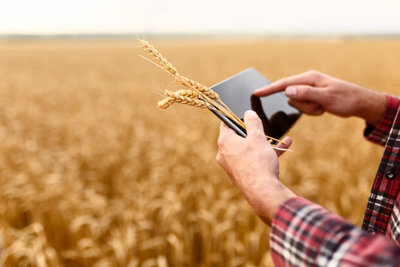The effervescence of digitisation in the agri-food sector is spilling over to agricultural machinery. Let us recapitulate the innovations shown by industry stakeholders at previous European agricultural machinery fairs. Revealing at the very beginning of this article that most of them are based on IoT technologies, should not come as a surprise. The European Commission estimates 70 - 80% of new farm equipment is built with a precision farming component, relying on network devices.
In this article, we list the most promising examples of what is possible when agricultural machinary is equipped with sensor technology. Our first stop brings us to Paris where SIMA takes place every year. Digital innovations cleared up most prizes at this event. Real-time agronomic and meteorological platforms showed their potential to work with Big Data derived from public as well as local networks. For instance, ARVALIS, an applied agricultural research organization, dedicated to arable crops. It combines data analysis and agronomic algorithms as a major tool to respond to societal challenges. Other exhibitors at this event presented multipurpose applications to boost the interoperability of devices and data alike. This facilitates the collaboration between manufacturers and end-users to generate added value by connecting otherwise underutilised machinery. Another highlight that we witnessed at SIMA were the advancements in autonomous vehicles. Among them were traffic safety systems that proactively inform drivers of networked cars about the position and status of agricultural machinery on their route.
In November 2017, AGRITECHNICA in Germany was the place to be in terms of agricultural machinery. AGCO/Fendt presented its line MARS (Mobile Agricultural Robot Swarms), machines able to sow fields 24/7 while preventing soil compression with their light 40 kg. Other exhibitors focused their efforts on camera systems to identify damaged crops by using drones with 3D cameras and LIDAR imagery. A great tool for insurance purposes to assess the status of crops after climatologic events such as hailstorms, intensive precipitation, night frost, ground softening or flooding. When it comes to the protection of wild life during harvesting seasons, one remarkable example used infrared sensors to identify animals and ultimately prevent accidents.
At the beginning of 2018, a jury awarded innovative technologies at FIMA in Zaragoza. Among the winners was a platform, monitoring the proliferation of phytosanitary products in intensive fruit orchards. With the help of IoT based sensors the treatments are closely monitored, and respective data embedded in a digital platform. Another awarded project introduced sensors into the cabins of machinery to assess driver behaviour. The constant adaptation based on parameters which focus on comfort, security and economy, results in less fuel consumption and extended duration of equipment. In a similar vein, one awarded project relies on satellite data such as GPS and real-time kinematic (RTK) to achieve higher positioning accuracy. In combination with sonar and scanners, such machinery avoids upcoming obstacles all by itself. Against the background of utilizing machine connectivity and data analytics to improve operational efficiency, we conclude our tour with a system that enables manure management by centralizing sensors linked to the cloud on a smartphone application.
As this is only a selection of promising digital innovations in agricultural machinery, we invite you to have a closer look at the events we visited throughout this article.